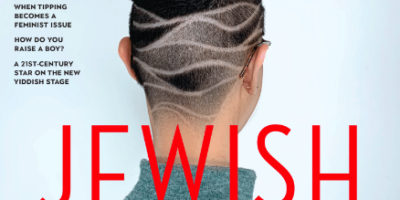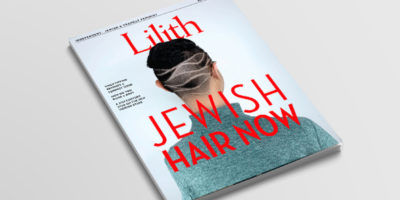
Illustration by Sivan Ellman
Head Covering: The Evolving Choices
My mother’s hair is colorful ropes of cotton, carefully and methodically wrapped in a rainbow of layers growing in width as the ends disappear into hidden corners below her hairline. As a girl, I often sat in my mother’s room, watching her in this morning ritual as she added the last detail of her dressing. Her movements fluid as she built her crown of fabric, adjusted the turban around her head for better comfort, and the way she took care to tuck in any stray hairs that had escaped the careful head wrapping. My mother’s hair made rare debuts. It was very short and very black, uncovered only in the mornings while she sipped her coffee. I fantasized about my mother’s hair, wondering what it would be like to witness her in the long wavy locks I had seen in the photographs of her before she was married, before she began covering. I longed to witness this femininity in my mother, to project into reality my own ideas of what a woman’s hair should be. But my mother’s hair was only ever a diadem of rich colored cloth.
Lots of things embarrassed me about my mother during adolescence, but for some reason, her turbans never did. Not in the secular public nor in our Orthodox Jewish community, where most married women wore synthetic wigs or snoods. It never embarrassed me because it came so naturally to her, was so much a part of who she was. These turbans she donned regally, her closet full of scarves hanging on hooks or folded in her armoire. I never questioned her choice to cover her hair this way, to stand out wherever she was. I also never questioned that I too would one day cover my own hair when I married. When I was young, it seemed inevitable, without question; I would cover. I hadn’t even liked my hair anyway.
I have boring hair. Brown. Limp. Easily tangled. At 14, I cut it all off. I’d had enough of my hair. My hair drew looks of daggers from the rabbi of my ultra-Orthodox high school. I was the only one with hair that short, a pixie cut—an utterly rebellious move, to stand out so blatantly. But then I missed that long, ugly disappointment of hair. By the time I was graduating, my hair was long again. I remember the small held breaths as my friend and I took turns laying down our heads on a towel, spreading out each other’s hair, and then, with a hot clothing iron, straightening each other’s hair stick-straight style. We risked burns at each other’s hands in order to obtain what we thought was a sleek, sexy look.
And then, only two years later, at the age of 19, I met my husband and we fell fast and heavily in love. I was engaged at 20 with a wedding on the horizon. And that is when the rainbow coverings fell out of grace. On my mother, the covering of her hair felt all-encompassing of her identity. I understood it not only as a religious observance but part of her artist’s dress. But when suddenly faced with the covering of my own hair, I panicked. It had only been a few years since I finally understood my hair, and when faced with the prospect of hiding it from the world I realized I wasn’t ready.
I have been married 14 years, and my relationship with covering my hair is still complicated. At first I covered with hats only on Shabbat. Then my sister passed on to me a human-hair wig which I wore on Shabbats and the holidays. I tried taking on covering my hair on Mondays, but it was too difficult and I gave it up, followed a short while later by taking on covering my hair on Fridays, an easy transition into my Shabbat covering practice, which I still do today. I own two human hair-wigs, one long and one short, to go with whatever hair length I might be sporting that year. On Fridays, I cover my hair like my mother. And I think of her each time I wrap my hair. I wrap it differently , a more modern look with a twisted knot at the top of my hairline. But my face morphs into hers. And it makes me miss being young again, watching her wrap her hair. An art form; my Jewish mother.
I don’t know if my daughters will choose to cover their hair when they are married. I don’t know if they are entranced with the ways I cover my own hair, or style it when it is uncovered. But they do rely on me now to care of their hair. The feel of their scalp beneath slippery suds as I bathe the younger ones. The row of girls before me as I brush and brush their hair—hair so spectacularly different from my own, shades of blonde and strawberry, all of them with body and curls—hair so thick I sometimes find myself enviously running my fingers through it. Such a palpable part of their personalities, the hair that grows from their heads in such symbolic manifestation of their unique selves. These daily rituals of washing and brushing, it’s hard to imagine one day all these locks might be locked away.
Talya Jankovits holds her MFA in creative writing from Antioch University and is a Pushcart Prize nominee.



